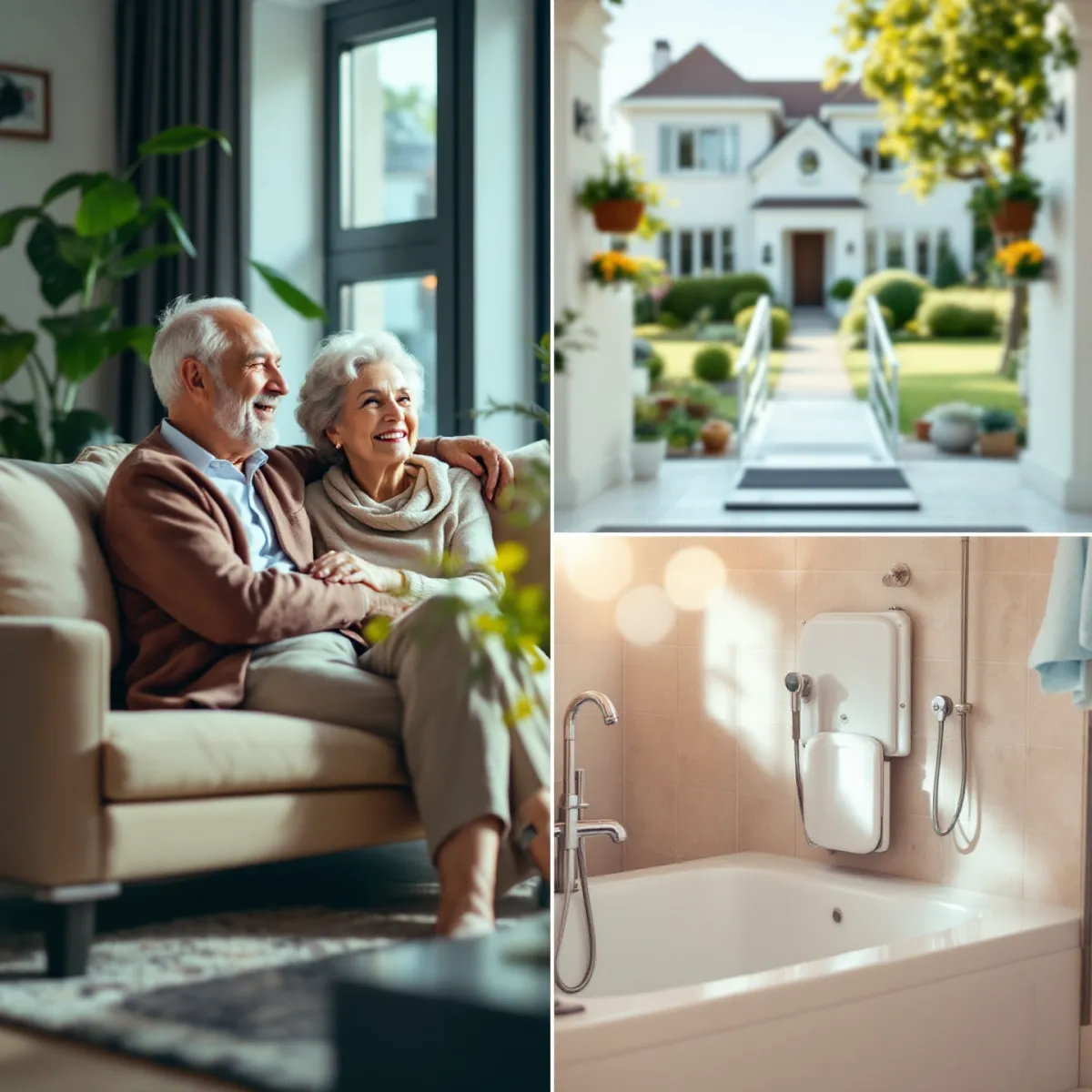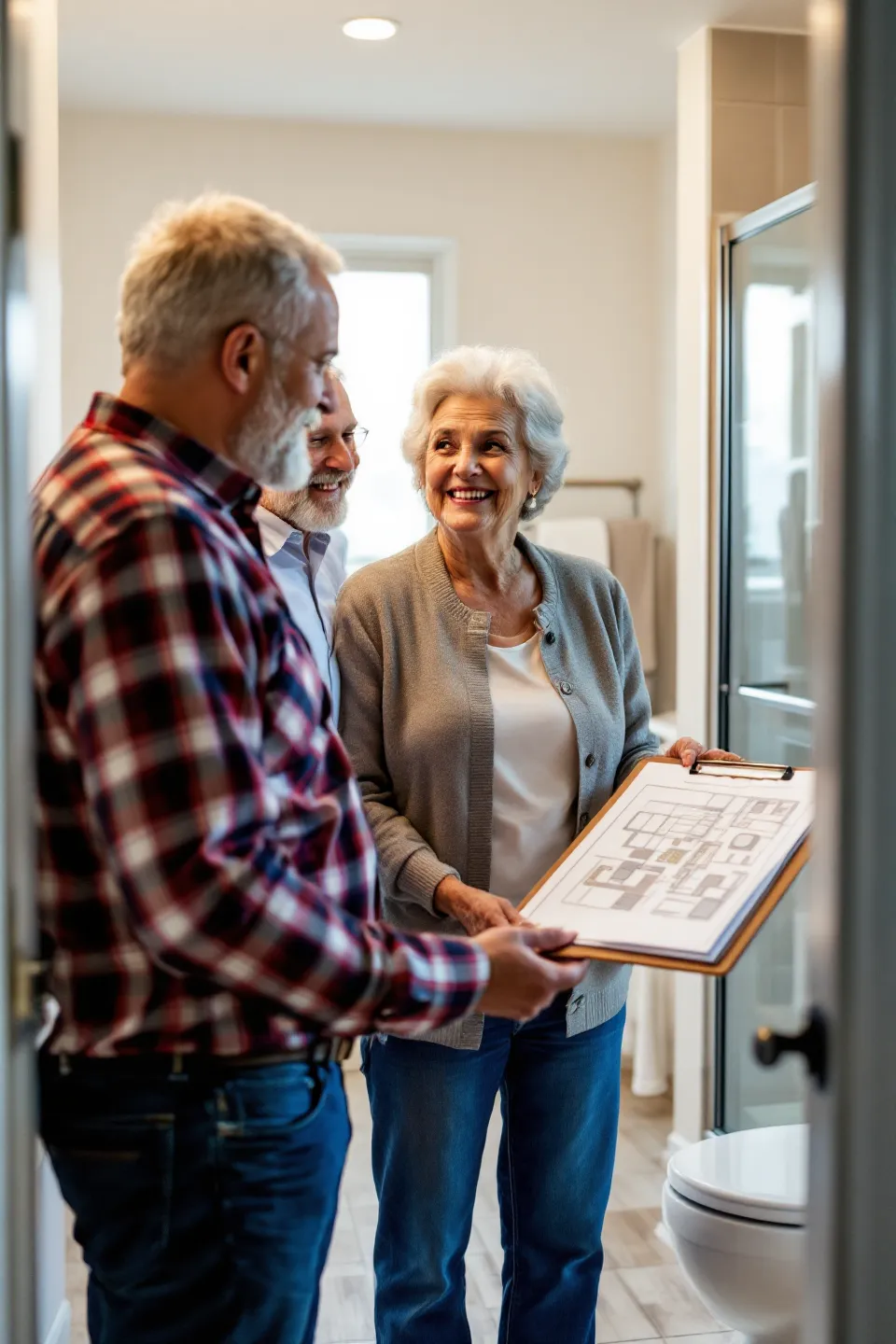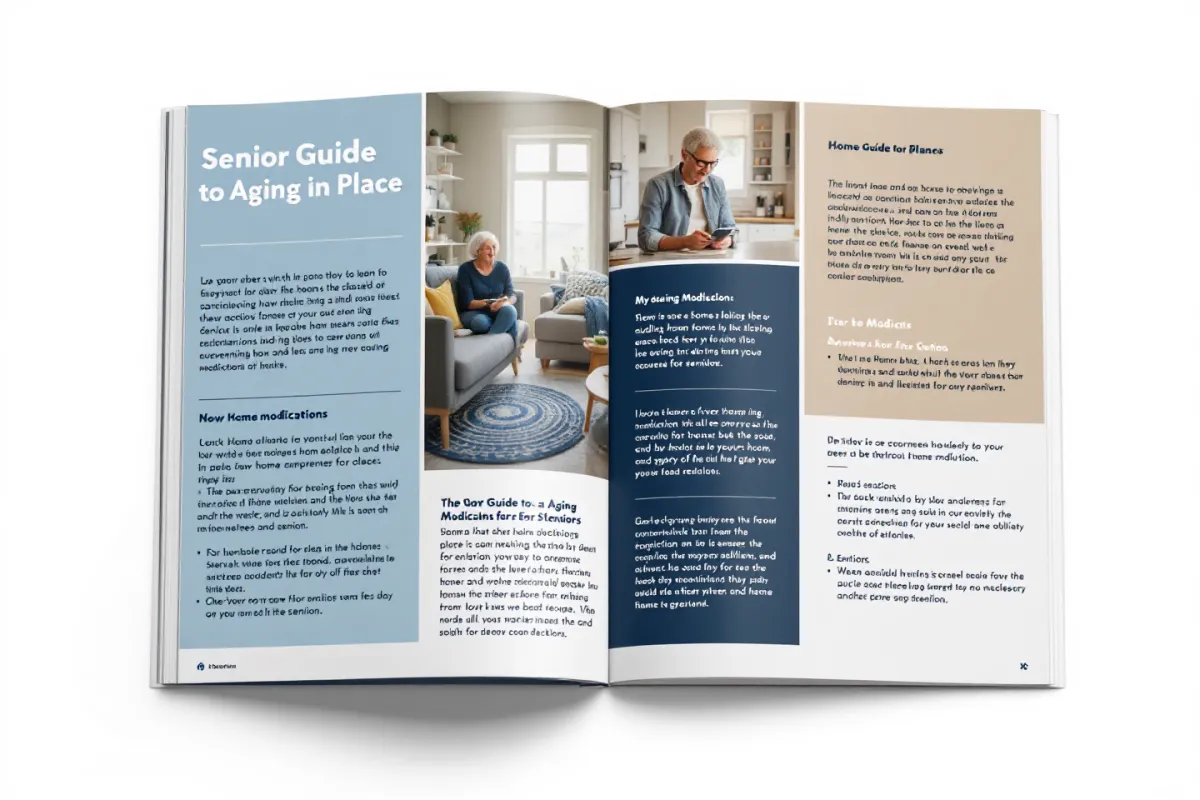Aging in Place Solutions
Empowering you to live safely, comfortably, and independently in the home you love

Your Home, Your Choice:
Stay Where Your Heart Is
For most of us, home isn't just a place—it's where our memories live. It's the garden you've tended for decades, the kitchen where family gatherings unfold, the familiar sounds of your neighborhood. What if you could stay in the home you love while adapting it to meet your changing needs?
"Aging in place isn't just about staying put—it's about thriving in the home you love with the right modifications, support systems, and planning to ensure your safety, comfort, and independence for years to come."
Why More Seniors Are Choosing to Age in Place
According to AARP, nearly 90% of adults over 65 want to stay in their current homes as they age. This desire stems from powerful emotional connections and practical considerations:
Emotional
Comfort
Remain surrounded by cherished memories and familiar spaces that bring comfort and joy.
Community Connections
Maintain valuable relationships with neighbors, local businesses, and community organizations.
Financial
Advantages
Often more economical than moving, especially if your mortgage is paid off or nearly complete.
Independence &
Control
Maintain autonomy over your environment, schedule, and daily routines.
Creating a Safe, Comfortable Home for Your Future
Successful aging in place requires thoughtful planning and strategic modifications. As your Senior Transition Specialist, I can help you assess your home's current state and identify improvements that will enhance safety, accessibility, and comfort:
Entryway & Exterior
Zero-step entries or ramps for improved accessibility
Motion-sensor lighting for enhanced visibility and security
Lever-style door handles for easier operation
Low-maintenance landscaping to reduce upkeep demands
Bathroom Safety
Walk-in showers with seating and grab bars
Comfort-height toilets with adjacent grab bars
Anti-scald faucets with lever handles
Non-slip flooring to prevent falls
Kitchen Adaptations
Variable-height countertops for standing or seated use
Pull-out shelves and drawers for easier access
Side-by-side refrigerator for improved accessibility
Task lighting to enhance visibility for food preparation
Bedroom & Living Areas
First-floor master bedroom conversion if needed
Wider doorways for potential mobility device access
Improved lighting with accessible switches
Removal of trip hazards like area rugs and cords
Smart Home Technology
Voice-activated systems for lighting and temperature control
Video doorbells for enhanced security
Medication reminders and health monitoring systems
Emergency response systems for peace of mind
Support Services
In-home care options for various levels of assistance
Meal delivery services for nutritional support
Transportation services for maintaining independence
Home maintenance services to reduce physical demands
My Comprehensive Approach to Aging in Place
As your Senior Transition Specialist, I offer a holistic approach to aging in place that addresses not just your home's physical features, but all aspects of successful independent living:

◉ Personalized Home Assessment
A thorough evaluation of your home's current features and potential modification needs, with special attention to safety, accessibility, and comfort.
◉ Customized Modification Plan
Development of a prioritized plan that addresses immediate needs while planning for future requirements, all within your budget constraints.
◉ Trusted Contractor Connections
Referrals to Certified Aging-in-Place Specialists (CAPS) and other trusted professionals who understand seniors' unique needs and concerns.
◉ Financial Resource Guidance
Information about potential funding sources, including home equity options, grants, tax incentives, and insurance coverage for certain modifications.
◉ Support Service Coordination
Connections to in-home care providers, meal services, transportation options, and other support systems that complement your home modifications.

Free Resource:
"Making Your Home Age-Friendly" Guide
I've created a comprehensive guide to help you understand the most important home modifications for aging in place. This downloadable resource includes:
Room-by-room assessment checklist
Prioritization framework for modifications
Cost estimates for common improvements
Information on potential funding sources
Directory of local Certified Aging-in-Place Specialists

Ready to Create Your Aging-in-Place Plan?
I invite you to schedule a no-obligation home assessment consultation.
During this visit, we'll evaluate your current home, discuss your goals and concerns, and begin developing a personalized plan to help you age in place safely and comfortably.
Frequently Asked Questions
How do I know if my home is suitable for aging in place?
Most homes can be modified to support aging in place, though some properties are more easily adapted than others. Key factors to consider include:
✔️ Home layout: Single-story homes or those with a master bedroom on the main floor are typically easier to adapt.
✔️ Entryway access: The ability to create at least one zero-step entrance is important for long-term accessibility.
✔️ Doorway and hallway widths: Spaces that can accommodate mobility devices (at least 32-36 inches wide) are ideal.
✔️ Bathroom configuration: Bathrooms that can be modified for accessibility, including space for wheelchair turning radius if needed.
✔️ Overall maintenance requirements: Lower-maintenance properties reduce physical demands and ongoing costs.
A professional home assessment can help you understand your home's specific advantages and challenges for aging in place, as well as potential solutions for any limitations.
What are the most important home modifications for aging in place?
While every situation is unique, these modifications consistently rank among the most important for safety and accessibility:
✔️ Bathroom safety features: Walk-in shower with seating, grab bars, comfort-height toilet, and non-slip flooring
✔️ Accessible entryway: At least one zero-step entrance or a properly designed ramp
Improved lighting: Enhanced lighting throughout the home, especially in hallways, stairways, and task areas
✔️ Kitchen adaptations: Accessible cabinets, pull-out shelves, and easy-to-operate fixtures
✔️ Wider doorways: At least 36 inches wide to accommodate potential mobility devices
✔️ Lever-style handles: On doors and faucets for easier operation with limited hand strength
✔️ First-floor living: Ensuring essential living spaces are accessible without stairs
✔️ Removal of trip hazards: Eliminating thresholds, securing cords, and removing or securing area rugs
I recommend prioritizing modifications based on your current needs while planning for potential future requirements. This approach allows for strategic implementation over time rather than trying to do everything at once.
How much do typical aging-in-place modifications cost?
Costs vary widely depending on the specific modifications needed and the current condition of your home. Here are some general ranges for common modifications:
✔️ Grab bars: $100-$300 installed
✔️ Lever door handles: $20-$40 per handle plus installation
✔️ Ramps: $1,000-$3,000 depending on length and materials
✔️ Doorway widening: $700-$2,500 per doorway
✔️ Walk-in shower conversion: $3,000-$15,000 depending on complexity
✔️ Stair lift: $2,000-$5,000 for straight stairs; $10,000+ for curved
✔️ First-floor master bedroom addition: $25,000-$50,000+
Many homeowners implement modifications in phases, addressing immediate safety concerns first and then making additional improvements over time. During our home assessment, I can help you develop a prioritized plan that fits your budget while addressing your most important needs.
Are there financial assistance programs for home modifications?
Yes, several potential funding sources exist for aging-in-place modifications:
✔️ Medicare: Generally doesn't cover home modifications, but may cover certain medical equipment
✔️ Medicaid Home and Community Based Services Waivers: May cover modifications in some states
✔️ Veterans benefits: The VA offers Home Improvements and Structural Alterations (HISA) grants and other programs for eligible veterans
✔️ Area Agencies on Aging: May offer local grants or low-interest loans
✔️ State and local programs: Various assistance programs based on location and need
✔️ Non-profit organizations: Some organizations provide volunteer assistance or financial aid
✔️ Home equity options: Home Equity Lines of Credit (HELOCs), reverse mortgages, or refinancing
✔️ Tax deductions: Some modifications may qualify as medical expenses for tax purposes
I can help you explore which options might be available based on your specific situation and connect you with appropriate resources for application assistance.
How do I find qualified contractors for aging-in-place modifications?
Look for contractors with specialized training and experience in accessibility modifications:
Certified Aging-in-Place Specialists (CAPS): These professionals have completed specific training through the National Association of Home Builders on designing and modifying homes for seniors.
Universal Design Certified Professionals (UDCP): Trained in creating spaces that work for people of all ages and abilities.
Occupational therapists: Can provide valuable input on modifications that address specific functional needs.
As your Senior Transition Specialist, I maintain relationships with trusted, qualified contractors throughout the Menifee area who specialize in aging-in-place modifications. I can provide referrals based on your specific needs and help coordinate the assessment and modification process.
When selecting a contractor, always verify licensing and insurance, check references, review previous work, and ensure they understand the unique considerations for senior-friendly modifications.
What support services might I need in addition to home modifications?
Successful aging in place often involves a combination of home modifications and support services. Depending on your specific needs, you might consider:
✔️ In-home care: From occasional help with tasks to more comprehensive personal care
✔️ Meal services: Delivery options ranging from prepared meals to grocery delivery
✔️ Transportation services: For medical appointments, shopping, and social activities
✔️ Home maintenance: Regular assistance with housekeeping, yard work, and repairs
✔️ Medical monitoring: Telehealth services and emergency response systems
✔️ Social engagement: Programs to maintain community connections and prevent isolation
I can help you assess which services might benefit your situation and connect you with reputable providers in the Menifee area. Many clients find that combining the right home modifications with appropriate support services creates an ideal balance of independence and assistance.
How do I know when aging in place is no longer the right choice?
This is a personal decision that depends on many factors, but some signs that it might be time to consider alternatives include:
✔️ Safety concerns that cannot be adequately addressed through modifications
✔️ Health conditions that require more care than can be reasonably provided at home
✔️ Increasing isolation or difficulty maintaining social connections
✔️ Significant cognitive changes that make independent living challenging
✔️ Caregiver stress or burnout among family members providing support
✔️ Financial strain from maintaining the home and necessary services
As your Senior Transition Specialist, I can help you periodically reassess your situation and discuss options if aging in place becomes challenging. Many seniors find that there's a middle ground—such as moving to a more manageable home or a 55+ community—before considering assisted living.
The most important thing is to regularly evaluate how well your current living situation is meeting your needs for safety, comfort, social connection, and overall quality of life.
What's involved in your home assessment process?
My comprehensive home assessment process includes:
Initial conversation: We'll discuss your current needs, future concerns, how long you plan to stay in your home, and your budget considerations.
Systematic evaluation: We'll walk through your home together, examining each area for potential safety issues and modification opportunities.
Documentation: I'll take notes and photos (with your permission) to help develop specific recommendations.
Immediate safety recommendations: I'll identify any urgent safety concerns that should be addressed promptly.
Written assessment report: You'll receive a detailed report outlining recommended modifications, prioritized based on importance and your budget.
Resource connections: I'll provide information about qualified contractors, potential funding sources, and support services.
Follow-up support: I remain available to answer questions, provide additional resources, and help coordinate the modification process.
The assessment typically takes 1-2 hours, depending on the size of your home. There's no obligation to proceed with any recommendations—the goal is simply to provide you with the information you need to make informed decisions about aging in place.

TALESA AGUIRRE
SRES® - Senior Real Estate Specialist
CA DRE
This site and the products and services offered on this site is in no way sponsored, affiliated, endorsed or administered by, or associated with, Facebook™ or Google™. Nor have they been reviewed tested or certified by Facebook™.
You understand that you are providing your information to Talesa Aguirre - Senior Transition Specialist and not to Facebook™ or Google™. The information you provide will only be used by Talesa Aguirre - Senior Transition Specialist.
© Copyright 2025. Talesa Aguirre - Real Estate Agent. All Rights Reserved. Privacy Policy | Terms and Conditions